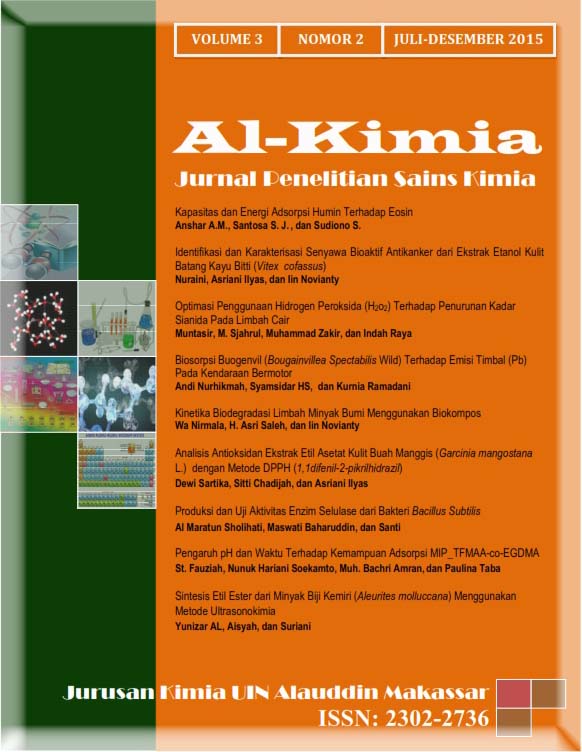Pengaruh pH dan Waktu Terhadap Kemampuan Adsorpsi Mip_TFMAA-co-Egdma
Abstract
A molecularly imprinted polymers (MIP) can be synthesized using functional monomers and template molecules through polymerization with the aid of cross linker. In previous studies, MIP_TFMAA-co-EGDMA was synthesized using the main ingredient tryfluoromethylacrylic acid (TFMAA) as functional monomer, b-sitosterol as a template molecule and ethyleneglycol dimethacrylate (EGDMA) as cross linker. The ability of adsorption against the effects of pH and contact Time of MIP has been evaluated. Variations of pH standard solution b-sitosterol were 4, 5, 6, and 7, while the time variation used were 30, 60, 90, and 120 minutes. The data of b- sitosterol concentrations adsorbed by MIP_TFMAA-co-EGDMA because of the influence of pH and contact times were analyzed using high pressure liquid chromatography (HPLC). pH5 gives the most influence on the adsorption capacity MIP_TFMAA-co-EGDMA against b-sitosterol. The number of b-sitosterol adsorbed on the pH was 1.0265 mg/g, while at 90 minutes was the best time for the MIP b- sitosterol adsorb as much as 1.3486 mg/g. Based on the adsorption kinetics study, the adsorption ability MIP_TFMAA-co-EGDMA against b-sitosterol in accordance with the pseudo second order kinetic model.
Downloads
References
Budi P., Hariani N., Taba P., Kasim H., dan Fauziah S., 2013. Sintesis dan Karakterisasi Molecularly Imprinted Polymers sebagai Adsorben Selektif β-sitosterol. Indonesia Chimica Acta, Vol.6, No. 2 ,102-108.
Jinfang W., Peter A.G.C., David C.S., and Ezat K., 2007. Synthesis and Characterization ofmicrometer-sized molecularly imprinted spherical polymer particulates prepared via precipitation polymerization. Pure Appl. Chem. Vol.79, No.9, 1505-1519.
Kim, H.; Spivak, D.A. 2003. New insight into modeling non-covalently imprinted polymers. J. Am. Chem. Soc, 125, 11269-11275.
Kugimiya A., Kuwada Y., Takeuchi T., 2001. Preparation of sterol-imprinted polymers with the use of 2-(methacryloyloxy)ethyl phosphate. Journal of Chromatography A., 938: 131-135.
Riapanitra, Anung.,. Setyaningtyas T., dan Riayani K., 2006. Penentuan Waktu Kontak dan pH Optimum penyerapan Metilen Biru Menggunakan Abu Sekam Padi. J. Molekul. 1(1) : 41-44.
Surikumaran H., Mohamad S., and Sarih M.N., 2014. Molecularly Imprinted polymer of Methaacrylic Acid Functionalised β-Cyclodextrin for Selective Removal of 2,4-Dichlorophenol. International journal of Molecularly Sciences., 15:6111-6136.
Walsh R., 2010. Development and characterisation of molecularly imprinted suspension polymers. Thesis Pharmaceutical and Molecular Biotechnology Research Centre Water ford Institute of Technology.
Yusof N.A., Appribeyan MD., Haron J., 2010. Synthesis and Characterization2+ of a Molecularly Imprinted Polymer for Pb Uptake Using 2-vinylpyridine as the Complexing Monomer. Sains Malaysiana 39 (5) : 829-835.
Zakaria N.D., Yusof N.A., Haron J. and Abdullah A.H., 2009, Synthesis and Evaluation of a Molecularly Imprinted Polymer for 2,4-Dinitrophenol. Int. J. Mol. Sci., 10: 354-365.
Zhu Q., Tang J., Dai J., Gu X., Chen S., 2007. Synthesis and Characteristics of Imprinted 17-b-estradiol Microparticle and Nanoparticle with TFMAA as Functional Monomer. Journal of Applied Polymer Science, Vol. 104: 1551-1558.
Authors who publish with this journal agree to the following terms:
1) Authors retain copyright and grant the journal right of first publication with the work simultaneously licensed under a Creative Commons Attribution License that allows others to share the work with an acknowledgement of the work's authorship and initial publication in this journal.
2) Authors are able to enter into separate, additional contractual arrangements for the non-exclusive distribution of the journal's published version of the work (e.g., post it to an institutional repository or publish it in a book), with an acknowledgement of its initial publication in this journal.
3)Authors are permitted and encouraged to post their work online (e.g., in institutional repositories or on their website) prior to and during the submission process, as it can lead to productive exchanges, as well as earlier and greater citation of published work (See The Effect of Open Access).


